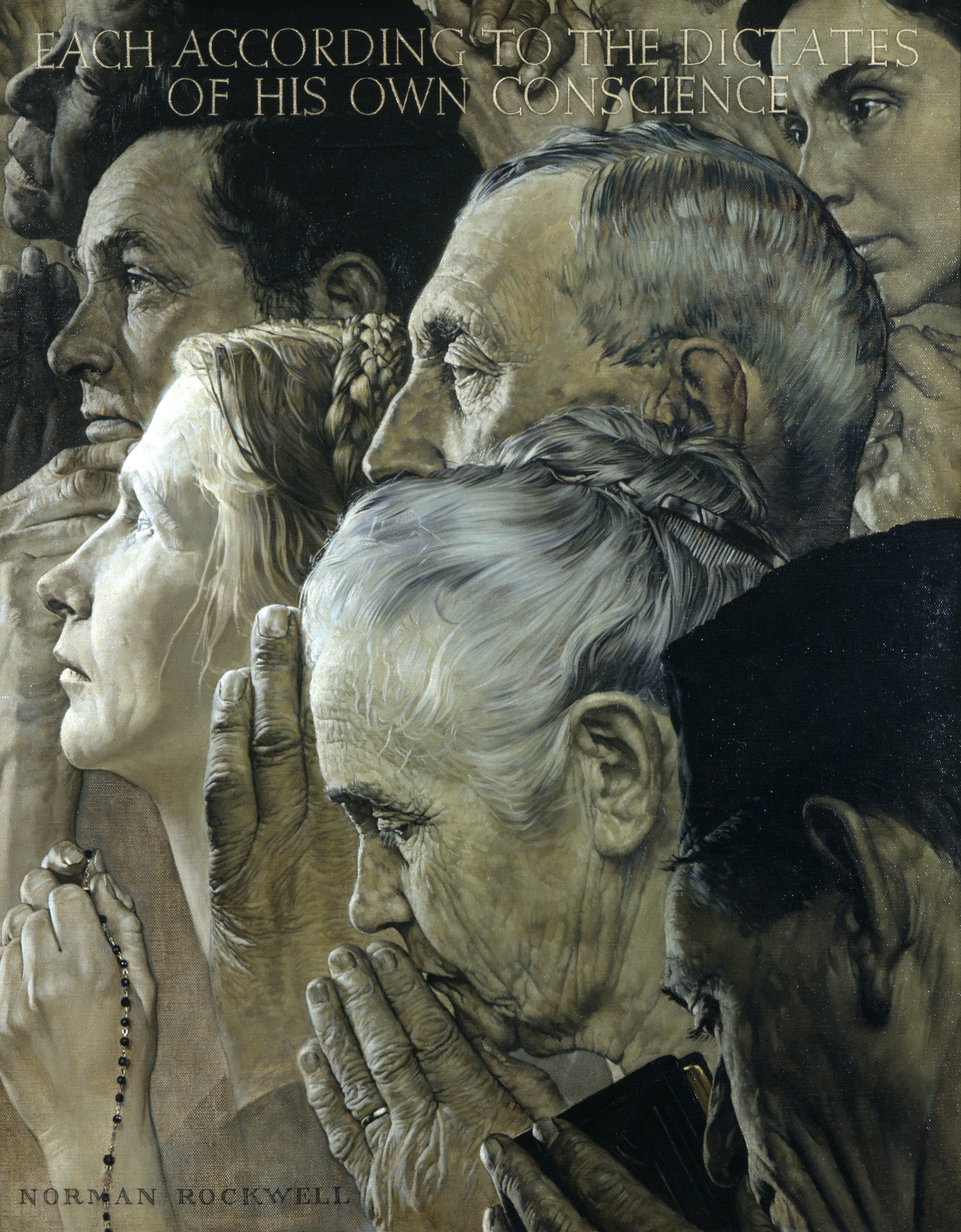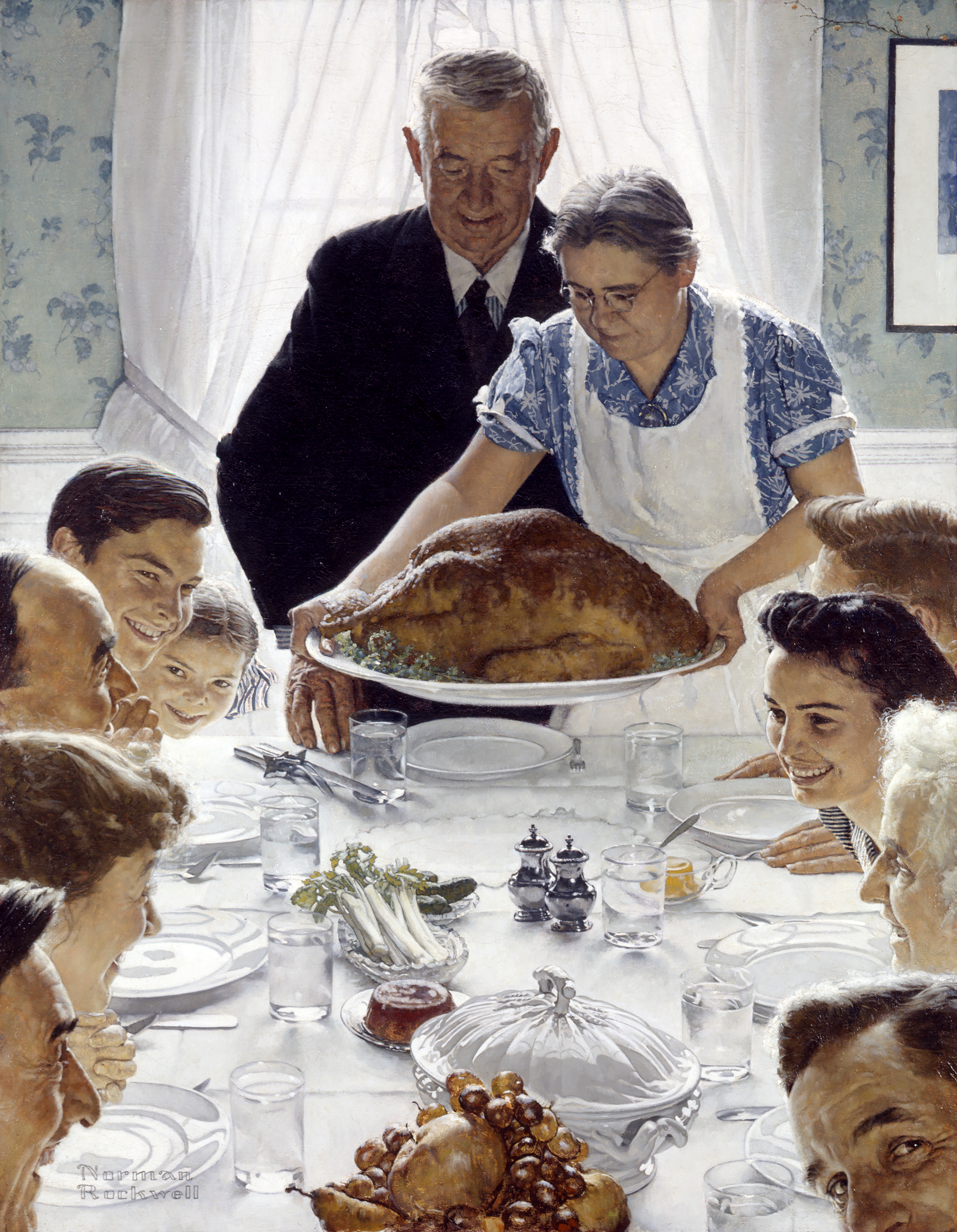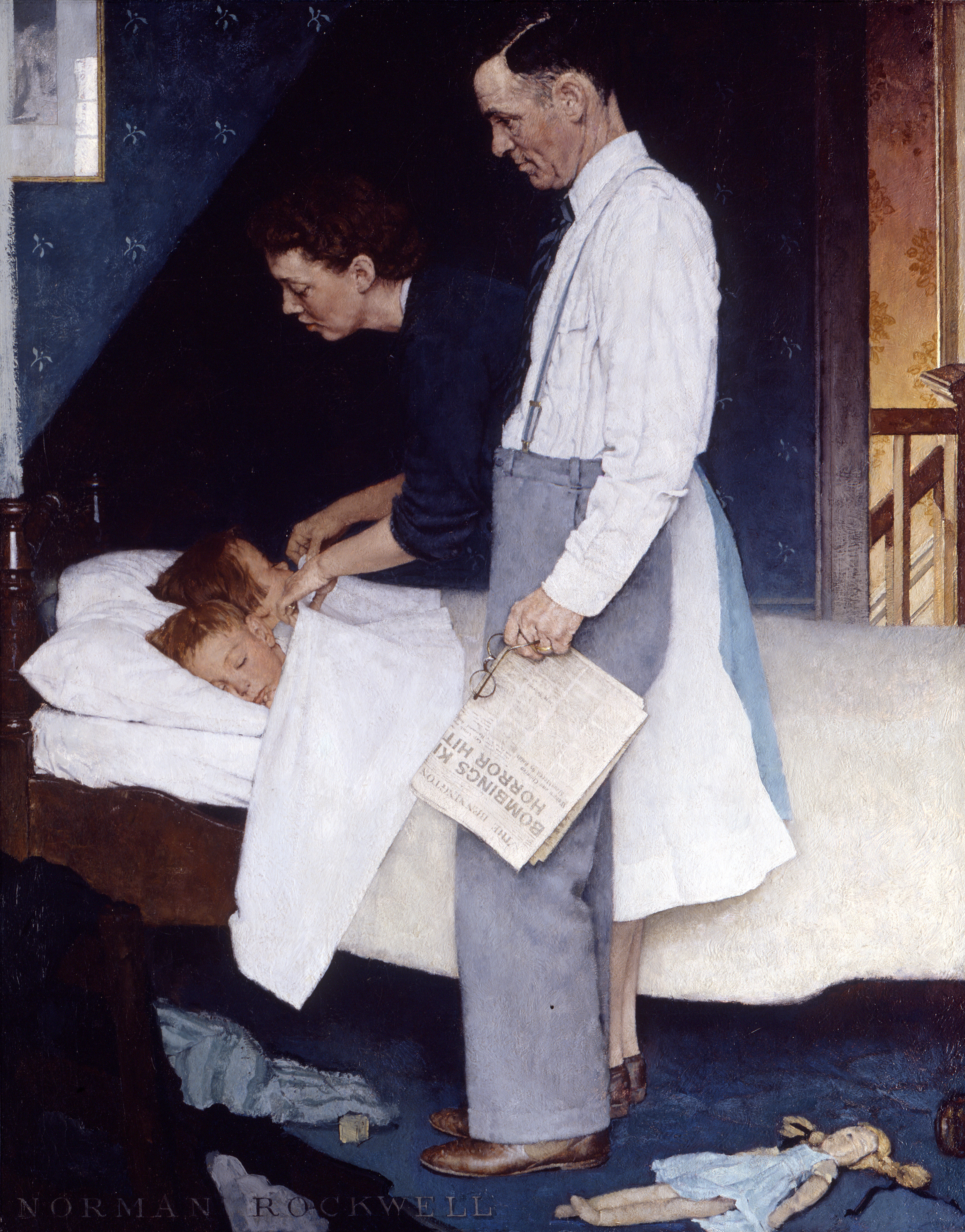Close Reading of the Four Freedoms Illustrations
Overview:
Students will be introduced to the Four Freedoms which President Roosevelt identified in his 1941 State of the Union Address to Congress. Each of the freedoms will be addressed individually. Through close reading of the illustrations by Norman Rockwell, students will identify details contained in the paintings. They will use these details to make and support inferences reflecting the meaning of the four freedoms in our everyday lives.
The lesson for each illustration should be about 40 minutes and taught over four different days.
Enduring Understandings/ Essential Questions:
- The Four Freedoms are for all citizens of the world.
- President Roosevelt named the Four Freedoms as Freedom from Want, Freedom from Fear, Freedom of Worship, And Freedom of Speech.
- The Four Freedoms are reflected in our lives.
- Are the four freedoms named by President Roosevelt relevant today?
- How are the Four Freedoms reflected in your life?
- Do all citizens of the world enjoy these freedoms in the same way?
- What does “freedom” mean to you?
- Grade
- 9-12
- Theme
- Four Freedoms
- Length
- The lesson for each illustration should be about 40 minutes and taught over four different days.
- Discipline
- Social Studies; Language Arts: Reading
- Vocabulary
- Freedom; Worship; Want; Fear; Parable; Need; Speech; Citizen
Background:
World War II began in 1939. The United States was not involved in the beginning of the war, however, President Franklin Roosevelt believed that the United States would eventually need to play a larger role. In January 1941, he made his speech to Congress. In his speech, President Roosevelt named the Four Freedoms, which he stated are the rights of everyone in the world. After the speech, in an effort to convey the underlying message of the Four Freedoms, the President reached out to the art world for help. Many artists created works to reflect the meaning of these freedoms in the form of paintings, sculptures, prints, musical compositions, and more. Norman Rockwell thought a lot about these ideals. In February and March of 1943, his completed Four Freedoms illustrations were published in The Saturday Evening Post, each along with a related essay. Exceedingly popular at the time and distributed widely as prints and posters, Norman Rockwell's illustrations raised over 132 million dollars toward the war effort through the purchase of war bonds. Prints of Rockwell’s Four Freedoms were given as premiums when people purchased war bonds in varying denominations. His illustrations became the face of the Four Freedoms and they continue to represent the meaning of these freedoms today.
Materials:
Multimedia Resources
Freedom of Speech
Freedom of Worship
Freedom from Want
Freedom from Fear
Norman Rockwell's Four Freedoms
Norman Rockwell Museum
Franklin D. Roosevelt's Four Freedoms
Norman Rockwell Museum
Classroom Supplies:
- Handout: President Roosevelt’s Address to Congress, January 1941 (Freedom Speech)
- Four Freedom illustrations and related text
- Chart paper with T-chart labeled “What I see(noticed)/ What I think (can infer)
- Marker
- Copies of related essays that were published with each illustration
Activities:
Each of the illustrations should be presented separately. Allow 30 to 40 minutes for the reading and discussion of each illustration. I recommend beginning with the illustration of Freedom from Want.
- Initiating Activity: Distribute a copy of President Roosevelt’s Freedom Speech
- Display the illustration of Freedom from Want.
- Ask students to look carefully at the illustration. Give them a few minutes to do this.
- Turn and Talk: When you feel enough time has passed, have students turn to a person sitting beside them. Ask them to share with each other some of the things they notice in the illustration. As they are sharing, listen in to some of the conversations.
- Have partners share out some of the things they noticed in the picture. Record their responses on chart paper. (Elicit noticings heard during partner talk that are not shared)
- Turn and Talk: When everyone has opportunity to share, have students turn to face their partners again. Tell them to talk to their partner about what they are thinking about the…
- Have partners share their thinking. Record responses on the T-chart. Elicit details from the picture to support their thinking.
- New observations may be contributed as they look closer and are thinking about the details. Add them to the appropriate column on T-Chart.
- Share the origin of the painting and its name. Give as much information as is appropriate for the maturity of the students. At some point, you may want to discuss the use of the word “want” in the title as many students may associate it with things they wish to have rather than “want of necessities” such as food, shelter, family and friends, water, etc. Share with them that there are four paintings in this collection. They will have opportunity to look at the others over the next week (or whatever schedule you determine best).
- Each of the illustrations was paired with a related essay. Provide students with a copy of the related essay after close reading of the illustration. Discuss the relationship between the each illustrations and their related essays.
Assessment:
- Did everyone participate?
- Were students able to give details from the picture to support their thinking?
- Are students able to identify the importance of the contributions made by President Roosevelt and Norman Rockwell?
- Can students relate the significance of the four freedoms in their lives?
Standards
This curriculum meets the standards listed below. Look for more details on these standards please visit: ELA and Math Standards, Social Studies Standards, Visual Arts Standards.
- CCSS.ELA-Literacy.RL.11-12.4
- Determine the meaning of words and phrases as they are used in the text, including figurative and connotative meanings; analyze the impact of specific word choices on meaning and tone, including words with multiple meanings or language that is particularly fresh, engaging, or beautiful. (Include Shakespeare as well as other authors.)
- CCSS.ELA-Literacy.RL.11-12.5
- Analyze how an author's choices concerning how to structure specific parts of a text (e.g., the choice of where to begin or end a story, the choice to provide a comedic or tragic resolution) contribute to its overall structure and meaning as well as its aesthetic impact.
- CCSS.ELA-Literacy.RL.11-12.6
- Analyze a case in which grasping a point of view requires distinguishing what is directly stated in a text from what is really meant (e.g., satire, sarcasm, irony, or understatement).
- CCSS.ELA-Literacy.RL.9-10.4
- Determine the meaning of words and phrases as they are used in the text, including figurative and connotative meanings; analyze the cumulative impact of specific word choices on meaning and tone (e.g., how the language evokes a sense of time and place; how it sets a formal or informal tone).
- CCSS.ELA-Literacy.RL.9-10.5
- Analyze how an author's choices concerning how to structure a text, order events within it (e.g., parallel plots), and manipulate time (e.g., pacing, flashbacks) create such effects as mystery, tension, or surprise.
- CCSS.ELA-Literacy.RL.9-10.6
- Analyze a particular point of view or cultural experience reflected in a work of literature from outside the United States, drawing on a wide reading of world literature.
- CCSS.ELA-Literacy.SL.11-12.1
- Initiate and participate effectively in a range of collaborative discussions (one-on-one, in groups, and teacher-led) with diverse partners on grades 11-12 topics, texts, and issues, building on others' ideas and expressing their own clearly and persuasively.
- CCSS.ELA-Literacy.SL.11-12.3
- Evaluate a speaker's point of view, reasoning, and use of evidence and rhetoric, assessing the stance, premises, links among ideas, word choice, points of emphasis, and tone used.
- CCSS.ELA-Literacy.SL.11-12.4
- Present information, findings, and supporting evidence, conveying a clear and distinct perspective, such that listeners can follow the line of reasoning, alternative or opposing perspectives are addressed, and the organization, development, substance, and style are appropriate to purpose, audience, and a range of formal and informal tasks.
- CCSS.ELA-Literacy.SL.11-12.6
- Adapt speech to a variety of contexts and tasks, demonstrating a command of formal English when indicated or appropriate. (See grades 11-12 Language standards 1 and 3 [link to="CCSS.ELA-Literacy.L.11-12"]here[/link] for specific expectations.)
- CCSS.ELA-Literacy.SL.9-10.1
- Initiate and participate effectively in a range of collaborative discussions (one-on-one, in groups, and teacher-led) with diverse partners on grades 9-10 topics, texts, and issues, building on others' ideas and expressing their own clearly and persuasively.
- CCSS.ELA-Literacy.SL.9-10.3
- Evaluate a speaker's point of view, reasoning, and use of evidence and rhetoric, identifying any fallacious reasoning or exaggerated or distorted evidence.
- CCSS.ELA-Literacy.SL.9-10.4
- Present information, findings, and supporting evidence clearly, concisely, and logically such that listeners can follow the line of reasoning and the organization, development, substance, and style are appropriate to purpose, audience, and task.
- CCSS.ELA-Literacy.SL.9-10.6
- Adapt speech to a variety of contexts and tasks, demonstrating command of formal English when indicated or appropriate. (See grades 9-10 Language standards 1 and 3 [link to="CCSS.ELA-Literacy.L.9-10"]here[/link] for specific expectations.)
- CCSS.ELA-Literacy.RI.11-12.1
- Cite strong and thorough textual evidence to support analysis of what the text says explicitly as well as inferences drawn from the text, including determining where the text leaves matters uncertain.
- CCSS.ELA-Literacy.RI.11-12.2
- Determine two or more central ideas of a text and analyze their development over the course of the text, including how they interact and build on one another to provide a complex analysis; provide an objective summary of the text.
- CCSS.ELA-Literacy.RI.11-12.7
- Integrate and evaluate multiple sources of information presented in different media or formats (e.g., visually, quantitatively) as well as in words in order to address a question or solve a problem.
- CCSS.ELA-Literacy.RI.11-12.9
- Analyze seventeenth-, eighteenth-, and nineteenth-century foundational U.S. documents of historical and literary significance (including The Declaration of Independence, the Preamble to the Constitution, the Bill of Rights, and Lincoln's Second Inaugural Address) for their themes, purposes, and rhetorical features.
- CCSS.ELA-Literacy.RI.9-10.1
- Cite strong and thorough textual evidence to support analysis of what the text says explicitly as well as inferences drawn from the text.
- CCSS.ELA-Literacy.RI.9-10.2
- Determine a central idea of a text and analyze its development over the course of the text, including how it emerges and is shaped and refined by specific details; provide an objective summary of the text.
- CCSS.ELA-Literacy.RI.9-10.7
- Analyze various accounts of a subject told in different mediums (e.g., a person's life story in both print and multimedia), determining which details are emphasized in each account.
- CCSS.ELA-Literacy.RI.9-10.9
- Analyze seminal U.S. documents of historical and literary significance (e.g., Washington's Farewell Address, the Gettysburg Address, Roosevelt's Four Freedoms speech, King's "Letter from Birmingham Jail"), including how they address related themes and concepts.
- D1.1.9-12.
- Explain how a question reflects an enduring issue in the field.
- D2.Civ.1.9-12.
- Distinguish the powers and responsibilities of local, state, tribal, national, and international institutions.
- D2.Civ.4.9-12.
- Explain how the U.S. Constitution establishes a system of government that has powers, responsibilities, and limits that have changed over time and are still contested.
- D2.Eco.13.9-12.
- Explain why advancements in technology and investments in capital goods and human capital increase economic growth and standards of living
- D2.Geo.5.9-12.
- Evaluate how political and economic decisions throughout time have influenced cultural and environmental characteristics of various places and regions.
- D2.Geo.7.9-12.
- Analyze the reciprocal nature of how historical events and the spatial diffusion of ideas, technologies, and cultural practices have influenced migration patterns and the distribution of human population.
- D2.His.1.9-12.
- Evaluate how historical events and developments were shaped by unique circumstances of time and place as well as broader historical contexts.
- D2.His.3.9-12.
- Use questions generated about individuals and groups to assess how the significance of their actions changes over time and is shaped by the historical context.
- D4.1.9-12.
- Construct an argument using precise and knowledgeable claims and evidence from multiple sources, while acknowledging counterclaims and evidentiary weaknesses.



